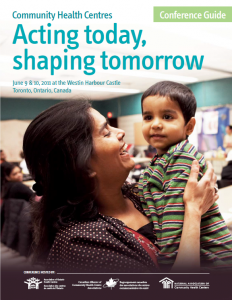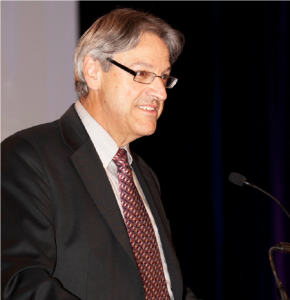2011 International Community Health Centres Conference
Acting Today, Shaping Tomorrow
 In June 2011, the worldwide Community Health Centre (CHC) movement gained major momentum at an international conference co-hosted by three Community Health Centre associations from North America: the Alliance for Healthier Communities (then known as AOHC), the Canadian Association of Community Health Centres (then known as CACHCA), and the United States’ National Association of Community Health Centers.
In June 2011, the worldwide Community Health Centre (CHC) movement gained major momentum at an international conference co-hosted by three Community Health Centre associations from North America: the Alliance for Healthier Communities (then known as AOHC), the Canadian Association of Community Health Centres (then known as CACHCA), and the United States’ National Association of Community Health Centers.
Over 800 delegates gathered in Toronto for the two-day conference to share ideas on how the Community Health Centre model can improve population health and strengthen sustainability of healthcare and social service systems around the world.
Speakers from a wide range of countries noted how community-centred primary health care is fast becoming the model of choice in countries such as Belgium, Australia, the Netherlands, Italy, China, Canada, the United States, Rwanda and South Africa.
A powerful statement in support of Community Health Centres was delivered by David Reynolds, Legislative Assistant to U.S. Senator, Bernie Sanders (Vermont). In accepting a global award on behalf of Senator Sanders, Reynolds noted: “It’s proven that CHCs save money. The George Washington University did a study that shows that for the $2 billion that are spent nationwide on CHCs, it actually serves to reduce expenses in other areas by $24 billion.”
 For delegates from the host country, Canada, one of the key highlights was a plenary address from Roy Romanow, former Premier of the province of Saskatchewan, who led a Canadian Royal Commission on Health.
For delegates from the host country, Canada, one of the key highlights was a plenary address from Roy Romanow, former Premier of the province of Saskatchewan, who led a Canadian Royal Commission on Health.
In his address, Romanow called for the federal government to implement a national strategy to expand access to Community Health Centres, a call echoed by representatives from one of Canada’s major political parties in attendance. The province of Ontario was cited as a leader among Canadian provinces for significantly increasing access to the Community Health Centres.
Perhaps the most significant moment of the conference came right at its start. Opening keynote speaker, Dr. Jan de Maeseneer, gave a rousing presentation about experiences with Community Health Centres in his native Belgium and around the world.
De Maeseneer urged participants to commit to establishing a global organization for Community Health Centres. This led, almost immediately following the conference, to development of a 2011 Memorandum of Understanding between Canadian, American and European CHC leaders to forge a new “International Federation of Community Health Centres” dedicated to expanding access to community-oriented primary health care around the globe. The rest, as they say, is history. The IFCHC was officially launched in July 2013.
Conference Videos
Conference Media Coverage
 The best kept secret in health care
The best kept secret in health care
By CAROL GOAR Columnist
Tues., June 14, 2011
The answer is right under our noses. It’s been there for 40 years.
Yet Ottawa and the provinces continue to pour billions of dollars into a quest for more efficient ways to deliver medical services; more businesslike ways to operate the health-care system; and more effective ways to keep people out of the hospital.
If they went back to the original vision of medicare, they’d find the less expensive, less bureaucratic alternative they’re looking for. And if they looked, they’d find dozens of working models.
Community health centres are the closest thing Canada has to Tommy Douglas’s dream: a health-care system that treats people, not symptoms. They deal with the underlying causes of illness: poverty, isolation, poor diet, mental disorders. They thrive in places where people don’t speak English, don’t have access to a family doctor and don’t know how to navigate Canada’s complex, rigidly compartmentalized medical system. They welcome anyone who walks in the door regardless of race, background, socio-economic status or sexual orientation.
Unlike family health practices (which are doctor-run), ambulatory care centres (which are managed by hospitals) or walk-in clinics (which provide fast, impersonal medicine), they are guided by the needs of the community. Some emphasize mental health services. Others concentrate on prenatal care, senior care or ensuring that their clients have healthy food and decent housing.
“When you’ve seen one community health centre, you’ve seen one,” said Jack McCarthy, chair of the Canadian Alliance of Community Health Associations.
Ontario has 73 community health centres. But most people don’t know they exist and most policy-makers regard them as a minor offshoot of mainstream medicine.
In an effort to showcase their work and build public awareness, more than 1,000 community health workers from across Canada, the United States, Australia, Belgium and the Netherlands gathered in Toronto last week. They shared their success stories and their frustrations.
“You guys are leading the way,” said Anita Mononian, chair of the National Association of Community Health Centers in the U.S. In her country, only 23 million people — 7 per cent of the population — are served by community health centres.
But even in Ontario, they are struggling to make inroads against the entrenched interests — hospitals, doctors, pharmaceutical companies and marketers of high-tech medical equipment — that claim most of the province’s $47 billion health budget.
Community health centres haven’t received any increase in funding since 2005, when George Smitherman was health minister. “We need to tell our story better,” said Adrianna Tetley, executive director of the Association of Ontario Health Centres. “We need to show we are saving the health system money down the road.”
Health Minister Deb Matthews, who spoke at the final session of the conference, was full of praise for community health centres. “What you do is not just the right thing to do for people in need, it is the right economic choice for government to make,” she said. “There is a special place in my heart for people who are drawn to community health centres.”
Regrettably, this has never been reflected in her spending priorities. And she offered no hope of more resources in the future.
Only two federal MPs — both New Democrats — and two journalists were there. Neither of the provincial opposition parties sent representatives.
But there were a few signs that the message is beginning to get through. The conference was sponsored by a chartered bank, a major law firm, a computer giant and three national insurance companies. Dozens of exhibitors — from architects to physiotherapists — set up booths.
The movement is still a long way from its breakthrough moment. But its leaders are learning to reach out and showing that the world wants what Canada has.
